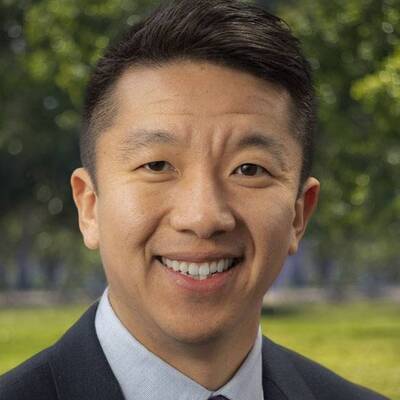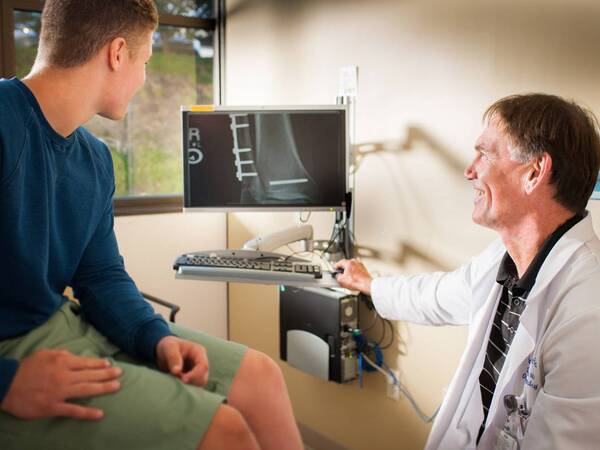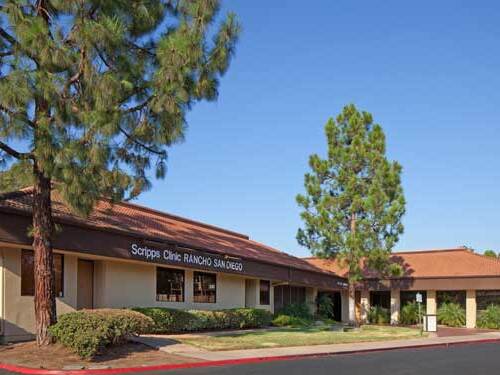Advanced surgery helps Tatum Vedder reclaim her active life
Innovative knee surgery at Scripps repaired severe injuries and helped young athlete Tatum Vedder return to the activities she loves.
Tatum Vedder has been a lifelong athlete. Soccer, gymnastics, softball, you name it. As a child, she played it. When Tatum was 10, volleyball took center stage and by the time she was 18, she was playing at the collegiate level. Then, in September 2019, the day before the start of her senior year, the athletic life as she’d always known it shattered.
Tatum was playing in a “just-for-fun” co-ed volleyball tournament when she jumped up to hit the ball as she normally would and landed on her left leg.
“When I landed, the upper part of my leg went inward and the rest went outward. The sound it made was louder than it felt, but I knew that it wasn’t good,” Tatum recalls. “Still, I had so much adrenaline that I didn’t think it was that serious — I just thought I’d sit out the rest of the game, even though I had to get carried off the court. Adrenaline has a way of numbing the pain and it didn’t really set in until I was leaving that tournament.”
Severe ACL and meniscus injury revealed
In all her years of playing sports, Tatum had never had a knee injury. This type of pain was entirely new, and she didn’t understand the severity right away.
“My experience with sports injuries had always been sprained ankles and back pain, nothing to do with my knees. But in hindsight, there was a lot of excessive stress to my knee joint because I had hiked Half Dome at Yosemite two weeks prior,” she says. “Then I played this just-for-fun tournament and I annihilated my knee. Even still, with my tough-it-out mentality, I didn’t go to the doctor until the next day.”
After seeing her athletic trainer, then her campus sports medicine physician and finally a surgeon, Tatum got the dreaded diagnosis that she had torn her anterior cruciate ligament (ACL) and her medial and lateral menisci (cartilage that acts as a shock absorber), which created a cartilage defect on her femur. That’s when reality set in: She was going to need surgery.
Years of procedures without relief
Tatum would spend the next four years in a seemingly endless cycle of surgery and rehab. She was living and traveling between Los Angeles, Santa Barbara and San Diego, seeing different physicians and having one unsuccessful procedure after another. She had reached a point of frustration and pessimism.
“Things were not going smoothly,” she says. “I went to a new surgeon, referral from the first surgeon and did surgery number three with him. But I wasn’t healing well, I was limping and in a world of pain. People kept telling me it was going to take time and therapy, but I was an A+ student at rehab and I just didn’t know how much better it was going to get.”
New surgical option brings hope
Hope returned when Tatum’s physical therapist told her about a seminar he’d attended featuring Tianyi (Tim) Wang, MD, an orthopedic surgeon and sports medicine physician at Scripps Clinic Encinitas and Scripps Clinic Jefferson in Oceanside. Dr. Wang was highlighting an innovative approach to knee surgery, which included meniscus and cartilage transplants as supporting procedures to treat torn ligaments. After three unsuccessful surgeries and years of rehab, Tatum was ready to try it.
“At this point, I knew in my gut that more rehab wouldn’t work,” she says.
There were other procedures out there, like plasma injections and hyaluronic acid, but I knew that my knee needed physical reconstruction. If you have a broken collarbone, you’d fix it, not just work around it. I knew I needed surgery.”
She met with Dr. Wang and was immediately reassured that surgery was the right step.
“Dr. Wang did all the things right: He had the right bedside manner, he explained things well and he was empathetic when I lost it in my first meeting with him, trying to accept that I needed another surgery,” Tatum says. “Sometimes surgeons use terminology that’s out of your scope, but he laid things out crystal clear. He told me that this was what he recommended, but ultimately, he said it was my decision. And after three or four years of feeling the way I did, I was ready to do anything to feel better.”
Advanced techniques for complex injury
When Dr. Wang met Tatum, he knew that she was a good candidate for the transplantation surgery.
“By the time Tatum saw me, she went through multiple surgeries and rounds of physical therapy and still couldn’t get back to her normal activity. She could barely climb stairs, let alone play sports, and had the knee of a 54-year-old at 24. She was a unique case — not only did she have a torn ACL, but also significant damage to the articular cartilage on the end of the bone and was missing meniscus tissues,” Dr. Wang recalls.
“In sports medicine, we see a lot of young athletes with these kinds of injuries, and historically we didn’t have much to offer them — maybe some exercises or cortisone injections until they were older and could get a knee replacement,” he continues. “Now, we can offer surgeries to treat the damaged cartilage, improve people’s pain and activity levels, delay the need for replacement and try to keep young people as active as possible. If we catch these injuries early, we can treat or reverse some of the damage and preserve the injured cartilage.”
Young, active and otherwise healthy, Tatum was an ideal candidate for the surgery.
With Dr. Wang, she had a four-part surgery, which included reconstructing the ACL, as well as using living cartilage and bone from a donor, removing damaged areas and replacing them with healthy samples.
Everything went as planned, Dr. Wang says.
“We do many of these surgeries, but it was Tatum’s dedication, hard work and commitment that gave her such a good result,” he says. “Having a patient who’s motivated and having a treatment team that’s motivated, that makes it all work. It’s a big surgery and a big recovery — and everyone must be committed to the same goal.”
“In sports medicine, we see a lot of young athletes with these kinds of injuries, and historically we didn’t have much to offer them . . . Now, we can offer surgeries to treat the damaged cartilage, improve people’s pain and activity levels, delay the need for replacement and try to keep young people as active as possible.”
Road to recovery
For Tatum, her goal started out simple: being able to walk up the stairs without pain. Now, a few years later, she’s back in the game, playing volleyball once or twice a week, surfing regularly, biking, lifting weights and planning major — maybe not Half Dome major — hikes.
“With the first two surgeries, I was determined to get back to volleyball. I had a window of opportunity to get back to my final season, but by surgery number three, it had been a couple of years and I started to develop resentment toward the sport. I would get traumatized seeing people jump and land,” Tatum recalls.
Thankful to be active again
Today, Tatum is grateful for how far she has come.
“I’m not totally where I was pre-injury, but I am very thankful that I am as active as I am right now,” she adds. “I have hope that there’s even more recovery to gain — that there’s an opportunity to get even better and not have inflammation. Snowboarding might be out, but surfing is not a problem at all. As a beach and ocean person, that’s something I am so grateful for.”
Tatum says she’s grateful for her personal support system that helped her through years of injury and recovery — and also grateful for her Scripps team for putting her on the road to recovery.
“Surgery at Scripps went really well, and my overall experience was great.” she adds. “I have heard from other people who had surgeries like mine and it was a long, drawn-out process. I feel like the surgery was seamless and relatively quick. Scripps makes the process easy, and I was able to get a hold of Dr. Wang any time I needed him.”
Scripps expertise keeps young athletes playing
Dr. Wang is also pleased with Tatum’s success and aims to achieve the same level of success with other young, active people.
“We here at Scripps specialize in these complex knee surgeries that may not have been possible before,” he says. “This is a population of young athletes that we are invested in and they have all their life to live ahead of them. They want to get back to their full potential after injuries, and we have the expertise to do that — even in complex cases like Tatum’s — with these state-of-the art procedures.”

This content appeared in San Diego Health, a publication in partnership between Scripps and San Diego Magazine that celebrates the healthy spirit of San Diego.
Related Providers








